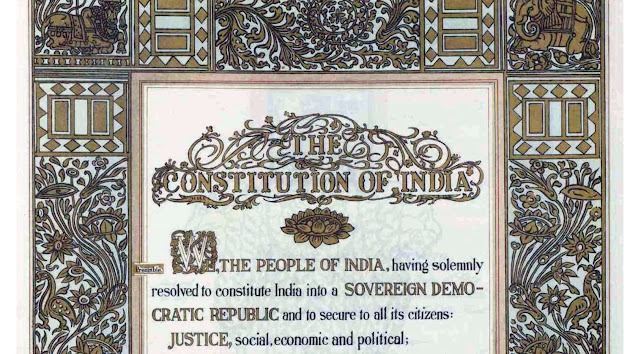Indian Constitution: If you are a citizen of India, then you must have heard that the Constitution of India came into force on 26 January 1950 and you may have also heard that the Indian Constitution is the largest constitution in the world, but today we We are going to tell you many such things related to the Indian Constitution which you might not have heard. If you have studied about the constitution or have read about it separately, then you may already know the things that we are going to tell you today, but today this post is going to be very useful for them. Those who do not have any knowledge about the constitution.
First of all, let’s talk about the preamble of the Indian Constitution-
“We, the people of India, having resolved to constitute India into a sovereign, socialist, secular, democratic republic, and to provide to all its citizens
To secure social, economic and political justice, freedom of thought, expression, belief, religion and worship, equality of status and opportunity,
And having determined to promote fraternity among all of them, which ensures the dignity of the individual and the unity and integrity of the nation, in this Constituent Assembly of ours, this day the 26th day of November, 1949, do hereby adopt, enact and give to ourselves this Constitution.”
So this is the Preamble of the Indian Constitution and now we tell you about the special things of the Indian Constitution-
The original copies of the Constitution are present in the Helium Chamber.
Yes, you hardly know that the original copies of the Indian Constitution, written in both Hindi and English languages, are stored in a special chamber filled with helium in the Parliament Library.
World’s largest constitution-
It is the most detailed constitution of any sovereign country in the world. The constitution is handwritten in both Hindi and English languages. Prem Bihari Narayan Raizada did the calligraphy.
2000 amendments were done in the first draft –
After debate and discussion, 2000 amendments were made in the constitution. It was signed by 284 members of the Constituent Assembly on 24 January 1950.
The first meeting of the Constituent Assembly in 1946 –
On December 9, 1946, the Constituent Assembly met for the first time, whose interim president was Dr. Sachchidanand Sinha.
It took almost 3 years to frame the constitution.
There were a total of 11 meetings of the Constituent Assembly. The last meeting took place between 14 and 26 November 1949, thus it took 2 years 11 months 18 days to reach the final draft of the constitution.
The artists of Santiniketan decorated-
Each page of the original constitution is decorated with paintings that were created by the artists of Shantiniketan, including Ram Manohar Sinha and Nandlal Bose.
That’s why the importance of January 26-
The Constitution was passed by the Constituent Assembly on 26 January 1949, since ‘Purna Swaraj’ was announced for the first time on 26 January 1930, hence it was implemented on 26 January 1950.
Our first Republic Day parade was not held on Rajpath-
Our first Republic Day parade was not held on Rajpath like today but in the grounds near Purana Quila in Delhi. Now there is the National Stadium. The parade was held on Rajpath for the first time in 1955.
Of the 12 Asian countries that became independent after 1945, the constitutions of only 3 countries survived. Our constitution has always stood true on every scale.
The Indian Constitution is one of the few constitutions in the world which has not only remained intact since its inception, but has been strengthened continuously. It is not that after its implementation on January 26, 1950, it did not face crisis during the 70 years, but each time it emerged as more powerful. According to American scholars Zachary Elkin, Tom Ginsberg and James Melton, the average age of constitutions around the world since 1789 has been only 17 years. The condition of the countries that got independence after the Second World War in 1945 is worse. Pakistan is an example of this, since August 14, 1947, three different constitutions have come into force there.
- India became independent in 1947, the constitution came into force in 1950 and till 2023 a new constitution did not have to be brought even once.
- Pakistan became independent in 1947, the constitution was implemented in 1956, the new constitution was implemented again in 1962, the new constitution was implemented again in 1972.
- Indonesia became independent in 1945, constitution implemented in 1949, new constitution implemented again in 1955, new constitution implemented again in 1959.
- Sri Lanka became independent in 1948, constitution implemented in 1972, new constitution implemented again in 1978.
- Vietnam became independent in 1945, constitution was implemented in 1960, new constitution was implemented again in 1980, new constitution was implemented again in 1992.
- Myanmar became independent in 1948, constitution implemented in 1962, new constitution implemented again in 1974, new constitution implemented again in 2008.
Discover more from THE LOKMAT
Subscribe to get the latest posts sent to your email.


